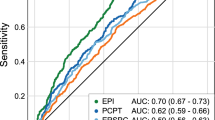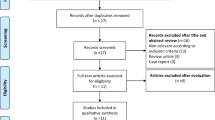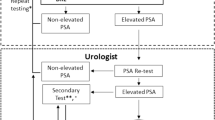Abstract
Background
Several liquid biomarker tests have been developed to account for the limitations of prostate specific antigen (PSA) screening prior to prostate biopsy. African ancestry is an established risk factor for prostate cancer (PCa) and must be particularly considered when evaluating patients with liquid biomarkers. While multiple tests have been developed over decades of exploration, recent advances can help patients and physicians incorporate data into a broader clinical context.
Methods
We sought to review currently available liquid biomarker tests in a practical, clinically directed fashion with particular focus on performance in men with African ancestry. We reviewed discovery and validation studies and highlight important considerations for each test.
Results
We discuss the advantages and limitations of percent free PSA, Prostate Health Index, Progensa® PCA3, ExoDx® Prostate Test, SelectMDx®, 4Kscore® Test, and Mi-Prostate Score and summarize salient studies on their use. A literature review of evidence specifically for men with African ancestry was conducted and available studies were summarized.
Conclusions
Liquid biomarkers can be useful tools for aiding in risk stratification prior to prostate biopsy. Use of such tests should be individualized based on a thorough knowledge of supporting evidence and the goals of the patient and physician. Further study should prioritize evaluation of such biomarkers in men with African ancestry.
This is a preview of subscription content, access via your institution
Access options
Subscribe to this journal
Receive 4 print issues and online access
$259.00 per year
only $64.75 per issue
Buy this article
- Purchase on Springer Link
- Instant access to full article PDF
Prices may be subject to local taxes which are calculated during checkout

Similar content being viewed by others
References
Catalona WJ, Smith DS, Ratliff TL, Dodds KM, Coplen DE, Yuan JJ, et al. Measurement of prostate-specific antigen in serum as a screening test for prostate cancer. N. Engl J Med. 1991;324:1156–61.
Kim EH, Andriole GL. Prostate-specific antigen-based screening: controversy and guidelines. BMC Med. 2015;13:61.
Mishra SC A discussion on controversies and ethical dilemmas in prostate cancer screening. J Med Ethics. 2020.
Jiang C, Fedewa SA, Wen Y, Jemal A, Han X. Shared decision making and prostate-specific antigen based prostate cancer screening following the 2018 update of USPSTF screening guideline. Prostate Cancer Prostatic Dis. 2021;24:77–80.
Dasarathy J, Rajesh R. PSA cancer screening: a case for shared decision-making. J Fam Pract. 2020;69:26;8;30;2;46.
Carroll PH, Mohler JL. NCCN Guidelines updates: prostate cancer and prostate cancer early detection. J Natl Compr Canc Netw. 2018;16:620–3.
Moher D, Liberati A, Tetzlaff J, Altman DG, Group P. Preferred reporting items for systematic reviews and meta-analyses: the PRISMA statement. Ann Intern Med. 2009;151:264–9. W64
Luderer AA, Chen YT, Soriano TF, Kramp WJ, Carlson G, Cuny C, et al. Measurement of the proportion of free to total prostate-specific antigen improves diagnostic performance of prostate-specific antigen in the diagnostic gray zone of total prostate-specific antigen. Urology. 1995;46:187–94.
Catalona WJ, Smith DS, Wolfert RL, Wang TJ, Rittenhouse HG, Ratliff TL, et al. Evaluation of percentage of free serum prostate-specific antigen to improve specificity of prostate cancer screening. JAMA. 1995;274:1214–20.
Catalona WJ, Partin AW, Slawin KM, Brawer MK, Flanigan RC, Patel A, et al. Use of the percentage of free prostate-specific antigen to enhance differentiation of prostate cancer from benign prostatic disease: a prospective multicenter clinical trial. JAMA. 1998;279:1542–7.
Lee R, Localio AR, Armstrong K, Malkowicz SB, Schwartz JS. Free PSASG. A meta-analysis of the performance characteristics of the free prostate-specific antigen test. Urology. 2006;67:762–8.
Mikolajczyk SD, Catalona WJ, Evans CL, Linton HJ, Millar LS, Marker KM, et al. Proenzyme forms of prostate-specific antigen in serum improve the detection of prostate cancer. Clin Chem. 2004;50:1017–25.
Loeb S, Sanda MG, Broyles DL, Shin SS, Bangma CH, Wei JT, et al. The prostate health index selectively identifies clinically significant prostate cancer. J Urol. 2015;193:1163–9.
Catalona WJ, Partin AW, Sanda MG, Wei JT, Klee GG, Bangma CH, et al. A multicenter study of [-2]pro-prostate specific antigen combined with prostate specific antigen and free prostate specific antigen for prostate cancer detection in the 2.0 to 10.0 ng/ml prostate specific antigen range. J Urol. 2011;185:1650–5.
de la Calle C, Patil D, Wei JT, Scherr DS, Sokoll L, Chan DW, et al. Multicenter evaluation of the Prostate Health Index to detect aggressive prostate cancer in biopsy naive men. J Urol. 2015;194:65–72.
Guazzoni G, Nava L, Lazzeri M, Scattoni V, Lughezzani G, Maccagnano C, et al. Prostate-specific antigen (PSA) isoform p2PSA significantly improves the prediction of prostate cancer at initial extended prostate biopsies in patients with total PSA between 2.0 and 10 ng/ml: results of a prospective study in a clinical setting. Eur Urol. 2011;60:214–22.
Lazzeri M, Haese A, Abrate A, de la Taille A, Redorta JP, McNicholas T, et al. Clinical performance of serum prostate-specific antigen isoform [-2]proPSA (p2PSA) and its derivatives, %p2PSA and the prostate health index (PHI), in men with a family history of prostate cancer: results from a multicentre European study, the PROMEtheuS project. BJU Int. 2013;112:313–21.
Bruzzese D, Mazzarella C, Ferro M, Perdona S, Chiodini P, Perruolo G, et al. Prostate health index vs percent free prostate-specific antigen for prostate cancer detection in men with “gray” prostate-specific antigen levels at first biopsy: systematic review and meta-analysis. Transl Res. 2014;164:444–51.
Tosoian JJ, Druskin SC, Andreas D, Mullane P, Chappidi M, Joo S, et al. Use of the Prostate Health Index for detection of prostate cancer: results from a large academic practice. Prostate Cancer Prostatic Dis. 2017;20:228–33.
White J, Shenoy BV, Tutrone RF, Karsh LI, Saltzstein DR, Harmon WJ, et al. Clinical utility of the Prostate Health Index (phi) for biopsy decision management in a large group urology practice setting. Prostate Cancer Prostatic Dis. 2018;21:78–84.
Bussemakers MJ, van Bokhoven A, Verhaegh GW, Smit FP, Karthaus HF, Schalken JA, et al. DD3: a new prostate-specific gene, highly overexpressed in prostate cancer. Cancer Res. 1999;59:5975–9.
Groskopf J, Aubin SM, Deras IL, Blase A, Bodrug S, Clark C, et al. APTIMA PCA3 molecular urine test: development of a method to aid in the diagnosis of prostate cancer. Clin Chem. 2006;52:1089–95.
Marks LS, Fradet Y, Deras IL, Blase A, Mathis J, Aubin SM, et al. PCA3 molecular urine assay for prostate cancer in men undergoing repeat biopsy. Urology. 2007;69:532–5.
Haese A, de la Taille A, van Poppel H, Marberger M, Stenzl A, Mulders PF, et al. Clinical utility of the PCA3 urine assay in European men scheduled for repeat biopsy. Eur Urol. 2008;54:1081–8.
Gittelman MC, Hertzman B, Bailen J, Williams T, Koziol I, Henderson RJ, et al. PCA3 molecular urine test as a predictor of repeat prostate biopsy outcome in men with previous negative biopsies: a prospective multicenter clinical study. J Urol. 2013;190:64–9.
Porpiglia F, Russo F, Manfredi M, Mele F, Fiori C, Bollito E, et al. The roles of multiparametric magnetic resonance imaging, PCA3 and prostate health index-which is the best predictor of prostate cancer after a negative biopsy? J Urol. 2014;192:60–6.
Nicholson A, Mahon J, Boland A, Beale S, Dwan K, Fleeman N, et al. The clinical effectiveness and cost-effectiveness of the PROGENSA(R) prostate cancer antigen 3 assay and the Prostate Health Index in the diagnosis of prostate cancer: a systematic review and economic evaluation. Health Technol Assess. 2015;19:i–xxxi. 1–191
Nilsson J, Skog J, Nordstrand A, Baranov V, Mincheva-Nilsson L, Breakefield XO, et al. Prostate cancer-derived urine exosomes: a novel approach to biomarkers for prostate cancer. Br J Cancer. 2009;100:1603–7.
McKiernan J, Donovan MJ, O’Neill V, Bentink S, Noerholm M, Belzer S, et al. A novel urine exosome gene expression assay to predict high-grade prostate cancer at initial biopsy. JAMA Oncol. 2016;2:882–9.
McKiernan J, Donovan MJ, Margolis E, Partin A, Carter B, Brown G, et al. A prospective adaptive utility trial to validate performance of a novel urine exosome gene expression assay to predict high-grade prostate cancer in patients with prostate-specific antigen 2–10 ng/ml at initial biopsy. Eur Urol. 2018;74:731–8.
Perner S, Mosquera JM, Demichelis F, Hofer MD, Paris PL, Simko J, et al. TMPRSS2-ERG fusion prostate cancer: an early molecular event associated with invasion. Am J Surg Pathol. 2007;31:882–8.
Tomlins SA, Day JR, Lonigro RJ, Hovelson DH, Siddiqui J, Kunju LP, et al. Urine TMPRSS2:ERG plus PCA3 for individualized prostate cancer risk assessment. Eur Urol. 2016;70:45–53.
Tosoian JJ, Trock BJ, Morgan TM, Salami SS, Tomlins SA, Spratt DE, et al. Use of the MyProstateScore Test to rule out clinically significant cancer: validation of a straightforward clinical testing approach. J Urol. 2021;205:732–9.
Vickers AJ, Cronin AM, Aus G, Pihl CG, Becker C, Pettersson K, et al. A panel of kallikrein markers can reduce unnecessary biopsy for prostate cancer: data from the European Randomized Study of Prostate Cancer Screening in Goteborg, Sweden. BMC Med. 2008;6:19.
Vickers A, Cronin A, Roobol M, Savage C, Peltola M, Pettersson K, et al. Reducing unnecessary biopsy during prostate cancer screening using a four-kallikrein panel: an independent replication. J Clin Oncol. 2010;28:2493–8.
Parekh DJ, Punnen S, Sjoberg DD, Asroff SW, Bailen JL, Cochran JS, et al. A multi-institutional prospective trial in the USA confirms that the 4Kscore accurately identifies men with high-grade prostate cancer. Eur Urol. 2015;68:464–70.
Zappala SM, Scardino PT, Okrongly D, Linder V, Dong Y. Clinical performance of the 4Kscore Test to predict high-grade prostate cancer at biopsy: a meta-analysis of us and European clinical validation study results. Rev Urol. 2017;19:149–55.
Vickers AJ, Vertosick EA, Sjoberg DD. Value of a statistical model based on four Kallikrein Markers in blood, commercially available as 4Kscore, in all reasonable prostate biopsy subgroups. Eur Urol. 2018;74:535–6.
Zappala SM, Dong Y, Linder V, Reeve M, Sjoberg DD, Mathur V, et al. The 4Kscore blood test accurately identifies men with aggressive prostate cancer prior to prostate biopsy with or without DRE information. Int J Clin Pract. 2017;71:e12943.
Konety B, Zappala SM, Parekh DJ, Osterhout D, Schock J, Chudler RM, et al. The 4Kscore(R) Test reduces prostate biopsy rates in community and academic urology practices. Rev Urol. 2015;17:231–40.
Sjoberg DD, Vickers AJ, Assel M, Dahlin A, Poon BY, Ulmert D, et al. Twenty-year risk of prostate cancer death by midlife prostate-specific antigen and a panel of Four Kallikrein Markers in a large population-based cohort of healthy men. Eur Urol. 2018;73:941–8.
Leyten GH, Hessels D, Smit FP, Jannink SA, de Jong H, Melchers WJ, et al. Identification of a candidate gene panel for the early diagnosis of prostate cancer. Clin Cancer Res. 2015;21:3061–70.
Van Neste L, Hendriks RJ, Dijkstra S, Trooskens G, Cornel EB, Jannink SA, et al. Detection of high-grade prostate cancer using a urinary molecular biomarker-based risk score. Eur Urol. 2016;70:740–8.
Haese A, Trooskens G, Steyaert S, Hessels D, Brawer M, Vlaeminck-Guillem V, et al. Multicenter optimization and validation of a 2-Gene mRNA urine test for detection of clinically significant prostate cancer before initial prostate biopsy. J Urol. 2019;202:256–63.
Smith ZL, Eggener SE, Murphy AB. African-American prostate cancer disparities. Curr Urol Rep. 2017;18:81.
Zavala VA, Bracci PM, Carethers JM, Carvajal-Carmona L, Coggins NB, Cruz-Correa MR, et al. Cancer health disparities in racial/ethnic minorities in the United States. Br J Cancer. 2021;124:315–32.
Catalona WJ, Partin AW, Slawin KM, Naughton CK, Brawer MK, Flanigan RC, et al. Percentage of free PSA in black versus white men for detection and staging of prostate cancer: a prospective multicenter clinical trial. Urology. 2000;55:372–6.
Fowler JE Jr., Sanders J, Bigler SA, Rigdon J, Kilambi NK, Land SA. Percent free prostate specific antigen and cancer detection in black and white men with total prostate specific antigen 2.5 to 9.9 ng./ml. J Urol. 2000;163:1467–70.
Schwen ZR, Tosoian JJ, Sokoll LJ, Mangold L, Humphreys E, Schaeffer EM, et al. Prostate Health Index (PHI) predicts high-stage pathology in African American Men. Urology. 2016;90:136–40.
Chiu PK, Ng CF, Semjonow A, Zhu Y, Vincendeau S, Houlgatte A, et al. A multicentre evaluation of the role of the Prostate Health Index (PHI) in regions with differing prevalence of prostate cancer: adjustment of PHI reference ranges is needed for European and Asian settings. Eur Urol. 2019;75:558–61.
Babajide R, Carbunaru S, Nettey OS, Watson KS, Holloway-Beth A, McDowell T, et al. Performance of Prostate Health Index in biopsy naive black men. J Urol. 2021;205:718–24.
Punnen S, Freedland SJ, Polascik TJ, Loeb S, Risk MC, Savage S, et al. A multi-institutional prospective trial confirms noninvasive blood test maintains predictive value in African American Men. J Urol. 2018;199:1459–63.
Kim EH, Andriole GL, Crawford ED, Sjoberg DD, Assel M, Vickers AJ, et al. Detection of high grade prostate cancer among PLCO participants using a prespecified 4-Kallikrein Marker Panel. J Urol. 2017;197:1041–7.
Darst BF, Chou A, Wan P, Pooler L, Sheng X, Vertosick EA, et al. The Four-Kallikrein panel is effective in identifying aggressive prostate cancer in a multiethnic population. Cancer Epidemiol Biomark Prev. 2020;29:1381–8.
O’Malley PG, Nguyen DP, Al Hussein Al Awamlh B, Wu G, Thompson IM, Sanda M, et al. Racial variation in the utility of urinary biomarkers PCA3 and T2ERG in a Large Multicenter Study. J Urol. 2017;198:42–9.
Feibus AH, Sartor O, Moparty K, Chagin K, Kattan MW, Ledet E, et al. Clinical use of PCA3 and TMPRSS2:ERG urinary biomarkers in African-American men undergoing prostate biopsy. J Urol. 2016;196:1053–60.
Author information
Authors and Affiliations
Contributions
GMH drafted the manuscript. GMH and EHK developed the search strategy, reviewed abstracts, and analyzed selected publications. All authors reviewed the final manuscript.
Corresponding author
Ethics declarations
Competing interests
Dr. Gerald Andriole serves as a medical consultant for Opko Health, Inc. There are no other potential conflicts of interest or relevant disclosures.
Additional information
Publisher’s note Springer Nature remains neutral with regard to jurisdictional claims in published maps and institutional affiliations.
Rights and permissions
About this article
Cite this article
Henning, G.M., Andriole, G.L. & Kim, E.H. Liquid biomarkers for early detection of prostate cancer and summary of available data for their use in African-American men. Prostate Cancer Prostatic Dis 25, 180–186 (2022). https://doi.org/10.1038/s41391-022-00507-8
Received:
Revised:
Accepted:
Published:
Issue Date:
DOI: https://doi.org/10.1038/s41391-022-00507-8
This article is cited by
-
Recent advances and future perspectives in the therapeutics of prostate cancer
Experimental Hematology & Oncology (2023)
-
Concerns regarding prostate cancer screening guidelines in minority populations
Prostate Cancer and Prostatic Diseases (2023)



